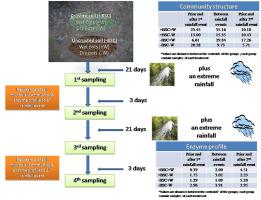当前位置:
X-MOL 学术
›
Eur. J. Soil Biol.
›
论文详情
Our official English website, www.x-mol.net, welcomes your
feedback! (Note: you will need to create a separate account there.)
Crust cover and prior soil moisture status affect the response of soil microbial community and function to extreme rain events in an arid area
European Journal of Soil Biology ( IF 3.7 ) Pub Date : 2020-11-01 , DOI: 10.1016/j.ejsobi.2020.103243 E.M. Papatheodorou , A. Papapostolou , N. Monokrousos , D.-W. Jones , J. Scullion , G.P. Stamou
European Journal of Soil Biology ( IF 3.7 ) Pub Date : 2020-11-01 , DOI: 10.1016/j.ejsobi.2020.103243 E.M. Papatheodorou , A. Papapostolou , N. Monokrousos , D.-W. Jones , J. Scullion , G.P. Stamou

|
Abstract Biological soil crusts (BSC) are an important multi-trophic component of arid ecosystems in the Mediterranean region, considered to have an important role in protecting the underlying soil from erosion and enhancing soil ecosystem functions. Using mesocosms in a 48 days glasshouse experiment, we investigated how previously hydrated (+W) and dried (-W) crust (+BSC) and uncrust (-BSC) -soil samples influenced microbial community structure, biomass and soil functionality of the underlying soils when exposed to two simulated extreme rain events. Community structure was assessed by phospholipid fatty acids analysis (PLFAs) and soil functionality by the activity of b-glucosidase, polyphenol oxidase, N-acetylglucosaminidase, acid phosphomoesterase and urease involve in C, P and N cycles. Crust increased the soil water content. In contrast, NH4 and NO3 were unaffected by the presence of the crust or its previous hydration status. N availability was affected by rain events; it declined from first to second event. Microbial biomasses were affected by the interaction crust x watering. Significant decline in biomasses was recorded in +BSC + W soils as a response to rain events. Little effects of treatments on soil enzymes were noticed; crust presence had a positive influence on the activity of phenol oxidase and a negative one on acid phosphomoesterase activity. The first rainfall had the greatest impact on microbial community structure, with communities in the previously hydrated crust affected most. These effects were less pronounced for the second rain event possibly due to microbial acclimation. Responses in enzyme profiles were consistent with those of communities, but delayed, with more marked responses following the second rainfall. We concluded that the effect of this lichen crust from the Mediterranean area on the response of soil microbial communities and enzymes to rainfall events depended strongly on the prior hydration status of the crust-soil complex.
中文翻译:

地壳覆盖和先前土壤水分状况影响干旱地区土壤微生物群落和功能对极端降雨事件的响应
摘要 生物土壤结皮(BSC)是地中海地区干旱生态系统的重要多营养成分,被认为在保护下伏土壤免受侵蚀和增强土壤生态系统功能方面具有重要作用。在 48 天的温室实验中使用中胚层,我们研究了先前水合 (+W) 和干燥 (-W) 地壳 (+BSC) 和非地壳 (-BSC) - 土壤样品如何影响微生物群落结构、生物量和底层土壤功能暴露于两次模拟极端降雨事件时的土壤。通过磷脂脂肪酸分析 (PLFA) 评估群落结构,并通过参与 C、P 和 N 循环的 b-葡萄糖苷酶、多酚氧化酶、N-乙酰氨基葡萄糖苷酶、酸性磷酸酯酶和脲酶的活性评估土壤功能。地壳增加了土壤含水量。相比之下,NH4 和NO3 不受地壳存在或其先前水合状态的影响。N 可用性受到降雨事件的影响;它从第一次事件下降到第二次事件。微生物生物量受到相互作用结壳 x 浇水的影响。+BSC + W 土壤中生物量显着下降,这是对降雨事件的响应。注意到处理对土壤酶的影响很小;地壳的存在对酚氧化酶的活性有积极的影响,对酸性磷酸酯酶的活性有消极的影响。第一次降雨对微生物群落结构的影响最大,以前水合地壳中的群落受影响最大。可能由于微生物适应,这些影响对于第二次降雨事件不太明显。酶谱中的反应与社区的反应一致,但有所延迟,在第二次降雨后有更明显的反应。我们得出的结论是,地中海地区的地衣地衣对土壤微生物群落和酶对降雨事件的响应的影响在很大程度上取决于地壳 - 土壤复合体的先前水合状态。
更新日期:2020-11-01
中文翻译:

地壳覆盖和先前土壤水分状况影响干旱地区土壤微生物群落和功能对极端降雨事件的响应
摘要 生物土壤结皮(BSC)是地中海地区干旱生态系统的重要多营养成分,被认为在保护下伏土壤免受侵蚀和增强土壤生态系统功能方面具有重要作用。在 48 天的温室实验中使用中胚层,我们研究了先前水合 (+W) 和干燥 (-W) 地壳 (+BSC) 和非地壳 (-BSC) - 土壤样品如何影响微生物群落结构、生物量和底层土壤功能暴露于两次模拟极端降雨事件时的土壤。通过磷脂脂肪酸分析 (PLFA) 评估群落结构,并通过参与 C、P 和 N 循环的 b-葡萄糖苷酶、多酚氧化酶、N-乙酰氨基葡萄糖苷酶、酸性磷酸酯酶和脲酶的活性评估土壤功能。地壳增加了土壤含水量。相比之下,NH4 和NO3 不受地壳存在或其先前水合状态的影响。N 可用性受到降雨事件的影响;它从第一次事件下降到第二次事件。微生物生物量受到相互作用结壳 x 浇水的影响。+BSC + W 土壤中生物量显着下降,这是对降雨事件的响应。注意到处理对土壤酶的影响很小;地壳的存在对酚氧化酶的活性有积极的影响,对酸性磷酸酯酶的活性有消极的影响。第一次降雨对微生物群落结构的影响最大,以前水合地壳中的群落受影响最大。可能由于微生物适应,这些影响对于第二次降雨事件不太明显。酶谱中的反应与社区的反应一致,但有所延迟,在第二次降雨后有更明显的反应。我们得出的结论是,地中海地区的地衣地衣对土壤微生物群落和酶对降雨事件的响应的影响在很大程度上取决于地壳 - 土壤复合体的先前水合状态。











































 京公网安备 11010802027423号
京公网安备 11010802027423号